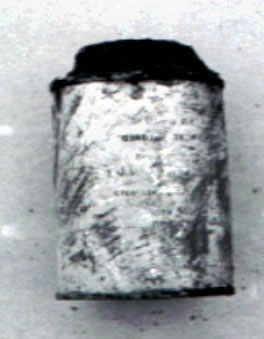
|
|
TOPICS |
|
What's New |
|
|

The DND UXO and Legacy Sites Program:
Questions & Answers
Question: What is UXO?
Answer: "UXO" stands for "Unexploded Explosive Ordnance". It is explosive ordnance that has been primed, fuzed, armed or otherwise prepared for action, and that has been fired, dropped, launched, or placed in a manner that constitutes a hazard to people, operations, or installations, and remains unexploded by malfunction or for any other reason. Examples include bombs, grenades, shells, mortars, flares, rockets, and mines, including mines used in marine environments.
Q: How will I know that something I find is UXO?
A: Determining that something is UXO is difficult, even for an expert. UXO comes in a great variety of shapes and sizes, from large bombs and other projectiles, to small ammunition. Some may be canister- or ball-shaped, some may look like a stick or baton, while others may look more like what we think of as a bomb or shell.
After it has been lying around for a time on the surface of the ground, buried, or underwater, UXO usually loses its original shape, paint and other markings. It may look more like a piece of old pipe, a pop can, an old car muffler, or bits of rusty metal than something you think of as a bomb, rocket or other ammunition. It is also unlikely to be resting on the surface of the ground; it is more likely to be buried with only small pieces exposed. Further identification is made difficult because UXO must not be touched or disturbed in any way - it can't be dug up or pulled out of the ground for examination. Even experts and trained personnel don't disturb items they can't identify. They usually try to detonate them in place, making sure that it is done safely for them and others. |
|
Q: What is a DND UXO Legacy Site?
- A site formerly owned, leased or used by DND that contains UXO resulting from past (historical) military operations.
- A site never in DND inventory that contains UXO resulting from past (historical) military operations.
- A shipwreck or other source of UXO that is within the 200-mile Canadian Exclusive Economic Zone.
In practical terms, it means that there are sites throughout Canada (on land, in rivers and lakes, and offshore) where UXO may be found. These contain explosives that can detonate and cause injury if disturbed.
Q: Why should I be concerned about UXO, especially if most of it has been around for a long time without causing any harm?
A: UXO contains explosive material that was at some point prepared to explode. For some reason, it either did not or only partially exploded. This means that it still has the potential to explode. In fact, some UXO becomes increasingly unstable the longer it is in soil or water.
UXO can also move or be exposed over time. For example, freeze-thaw cycles, flooding and storms can uncover buried ordnance or move it from place to place.
Q: If I walk or ride my bike over UXO, what will happen?
A: It is almost impossible to predict. In many cases, you will be lucky and nothing will happen. You might not even know it is there. Or, it might explode.
If it doesn't explode, but you know it's there, do not touch or otherwise disturb it. Leave the area and either call the police and tell them what you found, or ask an adult to call the police. Remember where you found the object - this is valuable information.
Q: Can't I just handle or move UXO gently?
A: No. For some buried or partially buried object there may be a temptation to try to uncover it to make more certain identification. Some UXO can be set-off by very little or no movement. Just leave it alone, and leave the area.
A:
- Don't touch it or disturb it in any way.
- Leave the area.
- Call your local emergency number (in most cases this will be 9-1-1), and ask for the police. Or, tell an adult (for example, your parents, teacher).
- Do not use a cell phone near UXO (this may cause it to explode).
- Report what you have found, and where you found it.
- Follow any instructions that you may be given by the emergency number.
Q: What should I do if my friends are playing with something that may be UXO?
A: Make sure that you stay safe (don't get too close to the object, move it or throw things at it) and try to get your friends to leave it alone - and tell them why. If this fails, leave the area and call your local emergency number, or tell an adult.
Q: How big an explosion will UXO cause?
A: That depends upon the design and size of the munitions, and how much explosive it contains. Some bombs or artillery shells are designed to destroy entire buildings. Any explosion can be extremely harmful.
Q: Once a legacy site has been identified, and a risk level determined, does this ever get re-evaluated?
A: Yes. Recurring reviews are a normal part of the UXO legacy site management process. For instance, some sites will be considered Low Risk because of remoteness of the property. Over time, they may become High Risk as human use of the property increases. These will be re-evaluated and managed accordingly.

UXO - Hidden Artillery Projectile
 Site Research Site Research |
| Publication Date: 2006 09 19 | Important Notices |

